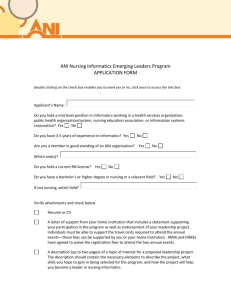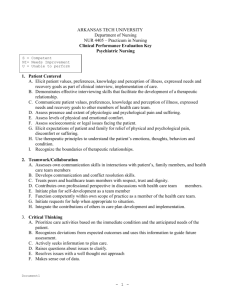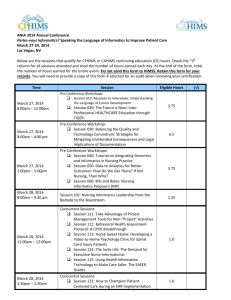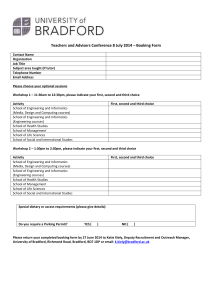The Miriam Hospital: Optimizing patient care, clinical practice
advertisement
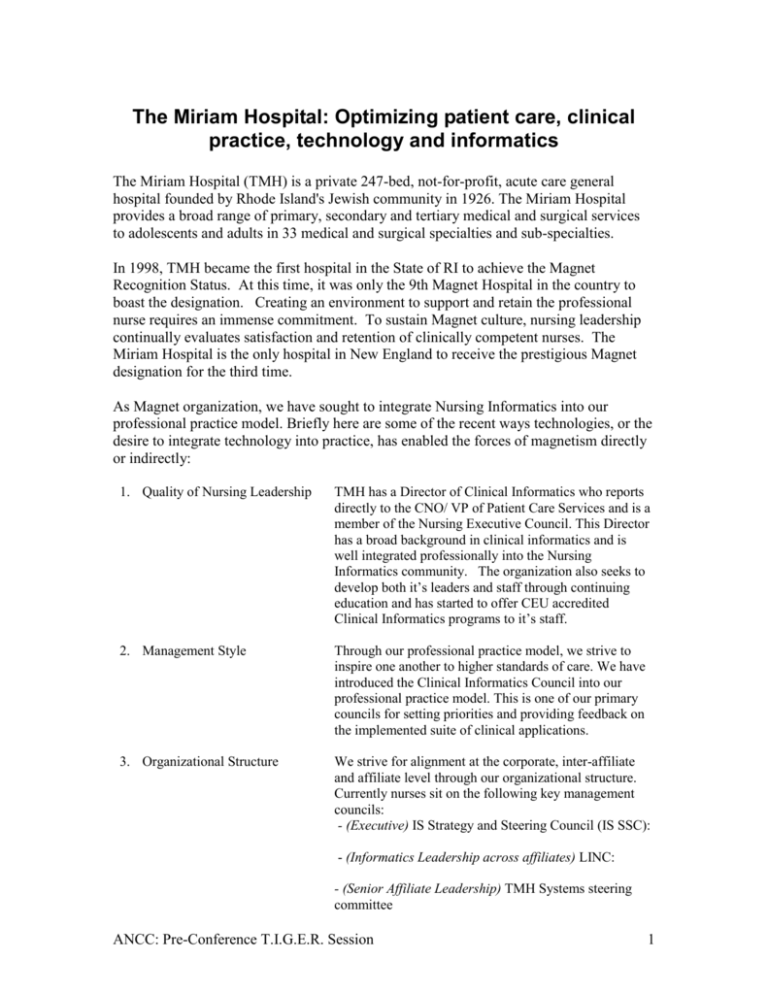
The Miriam Hospital: Optimizing patient care, clinical practice, technology and informatics The Miriam Hospital (TMH) is a private 247-bed, not-for-profit, acute care general hospital founded by Rhode Island's Jewish community in 1926. The Miriam Hospital provides a broad range of primary, secondary and tertiary medical and surgical services to adolescents and adults in 33 medical and surgical specialties and sub-specialties. In 1998, TMH became the first hospital in the State of RI to achieve the Magnet Recognition Status. At this time, it was only the 9th Magnet Hospital in the country to boast the designation. Creating an environment to support and retain the professional nurse requires an immense commitment. To sustain Magnet culture, nursing leadership continually evaluates satisfaction and retention of clinically competent nurses. The Miriam Hospital is the only hospital in New England to receive the prestigious Magnet designation for the third time. As Magnet organization, we have sought to integrate Nursing Informatics into our professional practice model. Briefly here are some of the recent ways technologies, or the desire to integrate technology into practice, has enabled the forces of magnetism directly or indirectly: 1. Quality of Nursing Leadership TMH has a Director of Clinical Informatics who reports directly to the CNO/ VP of Patient Care Services and is a member of the Nursing Executive Council. This Director has a broad background in clinical informatics and is well integrated professionally into the Nursing Informatics community. The organization also seeks to develop both it’s leaders and staff through continuing education and has started to offer CEU accredited Clinical Informatics programs to it’s staff. 2. Management Style Through our professional practice model, we strive to inspire one another to higher standards of care. We have introduced the Clinical Informatics Council into our professional practice model. This is one of our primary councils for setting priorities and providing feedback on the implemented suite of clinical applications. 3. Organizational Structure We strive for alignment at the corporate, inter-affiliate and affiliate level through our organizational structure. Currently nurses sit on the following key management councils: - (Executive) IS Strategy and Steering Council (IS SSC): - (Informatics Leadership across affiliates) LINC: - (Senior Affiliate Leadership) TMH Systems steering committee ANCC: Pre-Conference T.I.G.E.R. Session 1 - (Staff Nurse) Clinical Informatics Committee 4. Personnel Policies and Programs We have well defined job descriptions for both our Director of Clinical Informatics and Nursing Informatics Staff Specialist. 5. Community and the healthcare organization Last year we were awarded the 2007 Barnett Fain Quality Award for bringing our PVP (Pneumoccocal Vaccine) rates from 43% to 91.7%. This was through a team effort lead by our Director if Epidemiology. Yet the Nursing Informaticist played a vital role supporting education related to order entry and immunization tracking using our core clinical information system. We believe this allowed us to meet our quality goal and provided a valuable service to the community. 6. Image of Nursing One of the ways we are using technology to support this force of magnetism is thru the development of our recent Department of Nursing Intra-net. Our intra-net design that supports both our professional council structure and nursing departments. This site supports department based and council communication through council action logs, council minutes, and threaded discussions. There are also department specific hyper links and educational resources available in multiple formats . This site has been developed to support the professional practice model, communication and reflect the diversity of clinical nursing practice. Also the Clinical Informatics Council has identified a need for a patient safety brochure to help educate our patients about BCMA (bar coded medication administration) and their efforts to enhance medication safety at the point of care. 7. Professional Development Through staff participation, we are professionally active at the regional level (NENIC: New England Nursing Informatics Consortium), national level (HIMSS: Nursing Informatics Task Force) and with our academic partners (i.e. Rhode island College, University of Rhode Island, Salve Regina). We have also been able to provide nursing informatics educational offerings and in-services during clinical placements. We have also started to encourage staff to participate in Siemens, our core information systems vendor, Nursing Thought Leadership seminars. 8. Professional models of care On June 13 our Director of Clinical Informatics partnered with a Rhode Island College Assistant ANCC: Pre-Conference T.I.G.E.R. Session 2 Professor to present Nursing Education, Practice and Informatics: Partnering for the Future at RI’s Health Care Futures Grant Educational Summit. The focus of this presentation was an overview of a pilot to introduce students, during their clinical placement, to the affiliates information systems and Nursing Informatics. Also Clinical Informatics: Nurses developing an informatics culture and competencies was accepted, as a podium presentation, at this years ANCC’s Magnet Conference. The focus of this presentation will be a review of how TMH is integrating nursing informatics competencies, based on the work of Nancy Staggers et al., into the TMH culture. 9. Consultation and Resources The Department of Clinical Informatics has been involved in many projects, workflow analysis and efforts to prepare the organization for future systems. They frequently act as a resource on many application and integration issues. In addition, the department consults and acts as a resource to groups both in the community and affiliate: o To NENIC (New England Nursing Informatics Consortium) as Director of Program Planning integrating the needs of the service based organization into program planning; o To the RI Affiliate of MONE (Massachusetts Organization of Nurse Executives) in the overview of the 2007 Massachusetts Board of Higher Education and the Massachusetts Organization of Nurse Executives (MONE), Creativity and Connections: Building the Framework for the Future of Nursing Education and Practice. Specifically because one of the 11 competencies is informatics and looking at ways we can prepare the “Nurse of the future” from both the academic and practice perspective. o To the TMH Risk Management department on most root cause analysis related to multiple applications and specifically CPOE (Computerized Provider Order Entry) and BCMA (Bar Code Medication Administration). o To the Information Systems department designing, configuring and managing affiliate order sets and bringing the practice perspective intro the implementation lifecycle. o To care providers on a myriad of point of care ANCC: Pre-Conference T.I.G.E.R. Session 3 application issues. o Finally to nursing, staff and other ancillary departments as a bridge and translator to improve computer skills and information literacy. 10. Autonomy Many of the solutions are starting to introduce more nurse driven protocols and order sets. For instance, bringing our GENESIS protocols, our geriatric care standards, on-line. 11. Nurses as teachers The TMH Dept. of Clinical Informatics is involved in reaching out to various academe centers (i.e. Rhode Island College lecturer, RIC student mentor,). This year the Clinical Informatics Committee provided an overview of the systems, used throughout the organization and from a nursing perspective, with a goal of bringing this to the entire organization later this year. Partnering with our Center for Professional Practice Department (CPPD) to offer blended learning during our Medical Surgical Competency fair. A needs assessment was performed, learning deficits identified and a training program developed. In addition, the following tutorial ‘movies’ were developed and made available on the web site: o Viewing available blood products on-line; o Viewing the pharmacy profile; o Adding patient allergies; o Viewing the pharmacy profile on-line; o Revising heparin orders. Finally in 2007, we provided on going education and training for TMH staff specifically the following: o POM (CPOE) Training: 175 RN’s o MAK (BCMA) Training: 360 RN’s o POM for ED, VIR and Endo 12. Interdisciplinary Relationships We have both studied “The impact of healthcare technology on the role of Nurses and Interdisciplinary Communication” in 2005. Dykes, P. DNSc, RN; Cashen, M. PhD, RN; Foster, M. RN, MSN, FHIMSS, CPHIMS; Gallagher, J. RN; Kennedy, M. RN, MS; MacCallum, R. RN; Murphy, J. RN, BSN, FHIMSS; Schleyer, R. MSN, RN, BC, CPHIMS; Whetstone, S. RN, BC Surveying Acute Care Providers in the US to Explore the Impact of Health Information Technology on the Role of Nurses and Interdisciplinary Communication ANCC: Pre-Conference T.I.G.E.R. Session 4 in Acute Care Settings. CIN: Computers, Informatics, Nursing. 24(6):353-354, November/December 2006. Today we are reaching out to our physician colleagues to optimize clinical communications by the way orders are entered into our CPOE system. Specifically, our Clinical Informatics Committee is developing a “Dear Care Provider” letter outlining the “TMH Most Common CPOE Order Entry Tips” to be distributed to our order entry providers. 13. Quality improvement Since 2004, we have implemented the following solutions to improve the quality of care and patient safety: o Clinical Documentation in many of our procedural areas – Medhost in the ED, iPath intra-operatively and MACLab in the cardiac catheterization lab. o POM (CPOE) implemented throughout the inpatient areas with 94% of our physicians using the system o MAK (BCMA) implemented throughout the inpatient areas We implemented Vocera, an instant communication device, into our ED and Main OR to improve the quality of communication.. Highlights from a post implementation survey indicate that respondents agreed that the Vocera system enabled: A more efficient workflow (64%) More individual efficiencies (54%); Improved patient care coordination between staff (64%); Improved teamwork among nursing personnel (61%); Improved nursing staff ability to support each other (66%); Reduced time spend walking the unit to find people and making unnecessary trips (75%); Simplification of daily communication with other staff (59%). We are also developing Nurse driven order sets and protocols from recommendations form our Evidenced based best practices committee. We have specifically focused on discontinuing foley orders; oral care protocol; wound care order sets; geriatric consults and telemetry orders. 14. Quality of care Since we have introduced many technologies, we have ANCC: Pre-Conference T.I.G.E.R. Session 5 had the opportunity to study and evaluate many of these solution, specifically the following: o The unintended consequences of BCMA around patient identification, med error reporting and data management; o Medication reconciliation successes and failures; o Managing contrast media as a medication These are some of the ways technology has enabled the forces of magnetism. Yet we may want to think that the forces of magnetism are actually helping us shape technology. ANCC: Pre-Conference T.I.G.E.R. Session 6
